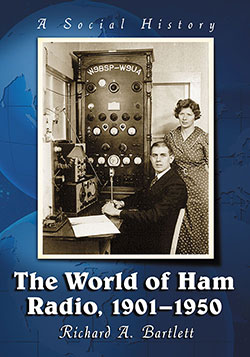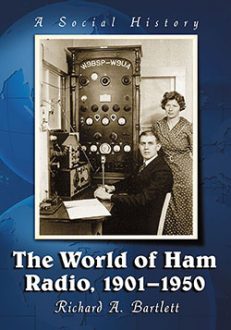The World of Ham Radio, 1901–1950
A Social History
$29.95
In stock
About the Book
During the first fifty years of the twentieth century, ham radio went from being an experiment to virtually an art form. Because of the few government restrictions and the low monetary investment required, the concept of ham radio appealed to various people. More than just a simple hobby, however, ham radio required its operators to understand radio theory, be able to trace a schematic and know how to build a transmitter and receiver with whatever material they might have available. With the advent of World War II and the increased need for cutting-edge communications, the United States government drew upon the knowledge and skill of these amateur ham radio operators.
This book explores the history of ham radio operators, emphasizing their social history and their many contributions to the technological development of worldwide communications. It traces the concept of relays, including the American Radio Relay League, from contacts as close as 25 miles apart to operators anywhere in the world. The book highlights the part played by ham radio in many of the headline events of the half century, especially exploration and aviation “firsts”. The ways in which these primarily amateur operators assisted in times of disaster including such events as the sinking of the Titanic and the 1937 Ohio River flood, are also examined.
About the Author(s)
Bibliographic Details
Richard A. Bartlett
Format: softcover (7 x 10)
Pages: 292
Bibliographic Info: 49 photos, appendices, notes, bibliography, index
Copyright Date: 2015 [2007]
pISBN: 978-1-4766-6275-6
eISBN: 978-1-4766-1260-7
Imprint: McFarland
Table of Contents
Acknowledgments vii
Introduction 1
1. The Beginnings 5
2. Hiram Percy Maxim and the Relay Concept 24
3. Amateurs During the First World War 40
4. Amateurs Between War and Peace 53
5. Surviving the Broadcast Revolution 64
6. Relays, DX-ing, Strange Languages, and Clubs 80
7. Amateurs as Experimenters and Adventurers 101
8. The Olympics, World’s Fairs, Trans Radio Press Service, and International Radio Conferences 116
9. Adventurous Amateurs at Sea and in the Air 130
10. More Amateurs and Aircraft: The NC-4, Byrd, the Dolebirds, the Lindberghs, and Others 140
11. Amateurs and Polar Exploration: Phase One 154
12. Amateurs and Polar Exploration: Phase Two 169
13. To the Rescue: Amateurs in Emergencies and Disasters 181
14. Amateurs on the Home Front: 1940–1945 200
15. Amateurs at War and Beyond: 1941–1950 211
Epilogue 231
Appendix A. Morse Code Alphabet 237
Appendix B. Q Signals and Other Abbreviations 238
Appendix C. Common Abbreviations in Amateur Morse Code 240
Chapter Notes 241
A Bibliographic Essay 261
Index 273
Book Reviews & Awards
“wonderful book…a welcome and long-overdue addition”—Communication Booknotes Quarterly.





